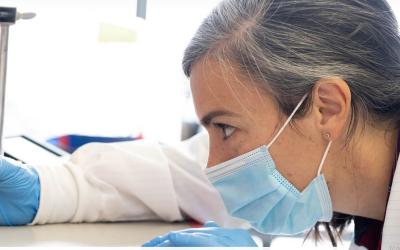
Welcome
Nearly 3 million Americans suffer from epilepsy. In one third of these patients available antiepileptic drugs or invasive surgical procedures are not effective. With an increased understanding of the molecular, electrophysiological and genetic bases of the epilepsies, hope for a cure emerges. Understanding the fundamental basis of epilepsies, especially those that occur in children, and using this information to develop novel treatments is the mission of our laboratory.
Research in the BarabanLab is based on a multi-disciplinary strategy. Techniques, briefly summarized here, include the use of in vitro brain slices for electrophysiological recording of membrane properties and synaptic function (using visualized patch-clamp and optogenetics methods); in vivo analysis of network function (using in silico probes and video-EEG monitoring); molecular analysis of gene expression using in situ hybridization and qPCR; immunohistochemical and morphological studies of neuronal structure and protein expression; pharmacological analysis including high-throughput drug screening in zebrafish; CRISPR-Cas9 based genome editing to generate epileptic zebrafish; and interneuron progenitor-based cell therapies.
In October of 2020, we transplanted pig MGE progenitor cells into a domoic acid poisoned epileptic California sea lion named Cronutt. Here is the original story published in the New York Times.
Cronutt video at 5 years after pig MGE transplantation; Rapt Productions
The laboratory occupies ~3000 sq. ft. of space located on the main Parnassus Campus at UCSF (Health Sciences East, 8th floor). Open lab space with 12 full-length benches is available to support “wet lab” functions and include benches dedicated to slice preparation, embryo dissection, RT-PCR, cell injection, slice preparation, in situ hybridization and immunohistochemistry. A separate bench is designated for “RNase free” work. A shared surgery and perfusion room with appropriate fume hood and sink is available as part of the 8th floor core facilities. Four individual rooms, each with electrophysiology set-ups are also available. An additional dedicated electrophysiology plus confocal imaging rig is equipped with a 3i Intelligent Imaging Innovations imaging and acquisition system with piezo stepper for volumetric imaging. One specialized set-up equipped with a Blackrock Microsystems integrated in vivo electrophysiology recording and behavioral imaging system is also available. The laboratory contains its own dedicated zebrafish aquarium room with 5 stand-alone six-shelf housing systems and the capacity to hold over 10,000 adult zebrafish. Nikon Eclipse confocal microscope, Leica stereomicroscopes, gel boxes, centrifuges, Leica cryostat, hybridization oven, shakers, Opentrons liquid handling robot and PCR (standard and qPCR) machines are available. DanioVision locomotion tracking systems running EthoVision software are also available. A state-of-the-art Ramona Optics Multi-Camera Array Microscope running custom machine-learning (ML) algorithms was added in 2023.
- In vitro electrophysiology including visualized patch-clamp recording
- In vivo electrophysiology and EEG in freely behaving animals
- Optogenetic and chemogenetic approaches
- Fast confocal GCaMP imaging in larval zebrafish
- Rodent and zebrafish behavioral assays
- Molecular biology (e.g., in situ hybridization and qPCR)
- CRISPR/Cas9 genome editing
- Immunohistochemistry
- Confocal and light-sheet microscopy
- Stereotactic surgery and cell transplantation
- Machine-learning based analysis of larval zebrafish behavior
"Well, I try my best,
To be just like I am,
But everybody wants you,
To be just like them"


